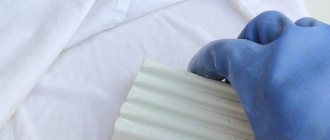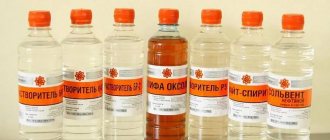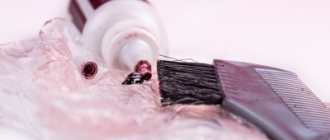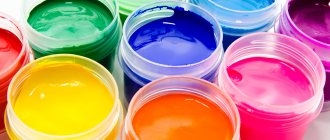During use, we can stain our clothes with a variety of substances. Some will leave no trace after washing, while others, on the contrary, will have unpleasant streaks and stains. To return the clothes to normal condition, we will have to remove the stains, and today we will tell you what to do if these stains were left by potassium permanganate.
Antiseptic composition of various consistencies
How to wash off potassium permanganate from skin using folk methods
There are a large number of folk methods for cleansing the skin from potassium permanganate, which are safe, but you must adhere to the recommended dosage.
Alcohol
Take a cotton pad and soak it in ethyl alcohol. Then, applying pressure, begin to scrub the stain. Wash the area with soap and water. This method will not erase everything in one go, so after 10 minutes have passed, repeat the procedure. There should be a lot of alcohol on the disc so that it is absorbed deeply into the skin.
Hydrogen peroxide
Soak a cotton pad in peroxide and apply to the spot on the skin for 15 minutes. Wash everything off with soap and water and repeat the procedure until results are achieved.
Citric acid
Cut a slice of lemon and apply it to your skin for 20 minutes. Then squeeze the citrus juice onto a cotton pad and rub off the potassium permanganate until you achieve the desired result.
Mustard
Pour mustard powder onto your fingers and rub it thoroughly into the stained area. After this, rinse everything off with water. If there are any wounds or scratches on the body, then cover them with an adhesive plaster before the procedure. There is a slight burning sensation during the cleaning process. To prevent your skin from drying out, apply a moisturizer after the procedure.
Pumice
Pumice can only help if there are fresh potassium permanganate stains on the skin. Apply soapy water to the stained area and scrub with a pumice stone.
Clay
Clay can be used in several ways:
- Soak the clay in water and wipe the potassium permanganate stain on your hand.
- We dilute the clay in warm water to form a thick mass. Then we apply it to the stained area, apply a plastic bag and tie it with a bandage for 2-3 hours.
Vinegar
Dilute vinegar with water and soak a cotton pad with it. Wipe the stained area, changing the tampon regularly. After the procedure, wash your skin with soap and water.
Ascorbic acid
Take 2-3 tablets of ascorbic acid and crush them using two spoons. Then pour into a glass of warm water and stir until completely dissolved. Soak a cotton pad or piece of cloth in the solution and wipe the area with potassium permanganate. It will be difficult to completely cleanse the skin using this method.
Laundry soap
If you need to get rid of slightly visible stains of potassium permanganate, then you can use ordinary laundry soap. Rub your palms to warm up and apply soap to them. Then wipe the stained area on your body until completely clean. The process is quite labor-intensive, so it will take a long time to process potassium permanganate stains.
Ammonium sulfide
Moisten a napkin or cotton pad with the substance and thoroughly wipe the stained area of skin. After the procedure, rinse everything off with water and apply moisturizer.
Removing manganese stains from clothing, furniture, and plumbing fixtures
Careless use of a concentrated manganese solution can lead to contamination of clothing, furniture surfaces, and plumbing fixtures. In these cases, laundry soap does not always help, although sometimes its use is quite effective.
Methods for removing potassium permanganate stains from plumbing fixtures:
- Treat the surface with bleach, leave for about 40 minutes, rinse.
- Apply a 10% solution of one of the acids: oxalic, acetic, citric, to the contaminated area, moisten generously, leave for 5 minutes, rinse. If necessary, repeat the procedure.
- Moisten the stain with a solution of equal parts methanol (wood alcohol) and 6%-9% vinegar, rub it and rinse.
- Mix hydrogen peroxide and citric acid (2:1), apply to a fresh (old) stain, leave for about ten minutes, rinse.
- The following composition will help remove potassium permanganate that has not had time to dry: rub laundry soap (200g), add hot water (1 liter) and 100g of baking soda or soda ash. Treat the plumbing, leave for 10 minutes, rinse.
- Add 2 tbsp to the previous composition. spoons of ammonia, cool, add mustard (1.5 tbsp), apply to the dirty area, rinse after 10 minutes.
- Rub dirt on acrylic surfaces with fine sandpaper, then rub this area with a special paste (can be purchased at construction departments).
- The use of Domestos is quite effective on various coatings of bathtubs and sinks.
Removing potassium permanganate from clothing:
- A universal remedy for any fabric: moisten the stain with lemon juice, rub, leave for 10-15 minutes, wash the item.
- For thin fabrics, kefir or yogurt is suitable: soak the contaminated part of the clothing for 6 hours, then wash the product by hand.
- White and light-colored clothing: apply a mixture of water and baking soda to the contaminated area, leave for at least 6 hours, rinse and wash the item.
- Denim: mix hydrogen peroxide with citric acid (1:1), moisten the stain, leave for about 10 minutes, rinse, wash the item.
- The drug Antipyatin can be used according to the instructions for the drug to various types of tissue.
Removing traces of manganese from various surfaces:
- Paper: moisten the stain with water, then treat with bleach, after an hour, remove the liquid with a soft sponge, let the paper dry and, if necessary, iron with a hot iron.
- Floor, dishes: dissolve a piece of crushed laundry soap and a piece of baby soap in a liter of hot water, add soda (2 tbsp) and essential oil (2-3 drops), treat the mark, rinse.
- Solvents are suitable for removing stains on linoleum, wooden floors, and dishes. Before use, check the effect of the product.
- For various floor coverings, you can use Domestos plumbing cleaner, a composition of equal parts hydrogen peroxide and citric acid, taken in equal parts.
https://youtube.com/watch?v=VQzEE6ZODwI
- For upholstered furniture, the same products are suitable as for clothing, a product based on laundry soap (described above), a mixture of equal parts of citric acid and hydrogen peroxide. Apply the product to the stain, rub the stain, and leave for a few minutes. Blot remaining liquid with a towel. Before use, test the effect of the drug on the upholstery fabric in an inconspicuous area.
- To remove stains on a carpet, it is possible to use the listed mixtures for clothing, Vanish for cleaning carpets, Vanish for removing stains.
Any product is more effective if used on fresh stains.
How to remove traces of potassium permanganate on the skin using chemicals
Chemical agents are more effective in removing potassium permanganate, but they can harm the surface of the skin. Before use, cover all damaged areas with adhesive tape.
White Spirit
This substance can clean potassium permanganate in a few minutes, but it can only be used on hands. Soak a napkin or cotton pad in the chemical and apply to the stained area. After the procedure, rinse everything off with water and apply moisturizer.
White
The substance is used to bleach clothes and has a high concentration that can cause burns. To use on the skin, make a solution in proportions 5x1, dilute water and bleach, and moisten a cotton pad or napkin with it. After the procedure, wash your skin thoroughly with soapy water.
Sodium hypochlorite
A weakly effective means for cleaning potassium permanganate, but safe to use, since it is used to treat wounds and scratches. Dampen a napkin in it and wipe the stained area of skin.
Chloramine
This chemical quickly damages the skin, so dilute the solution with water in proportions of 10x1. Rub your hands with it and leave to dry for 2-3 minutes. The procedure can be repeated no more than two times in a row.
Features of pollution
Potassium permanganate, or potassium permanganate, is a universal antiseptic that is used to disinfect wounds and planting material. All you need to prepare the solution is stir the pink powder in water. When using an antiseptic, accidents happen and the liquid ends up on the floor, clothes and furniture.
Manganese solution stains cannot be washed off with water or cleaning agents. And a strong concentrate generally destroys the upper layers of the fabric, as if burning the fibers.
Manganese cannot be washed from clothes even with the most expensive powders and bleaches. It is recommended to use acids for cleaning.
How to remove potassium permanganate from clothes
Even the highest concentrates can be used. However, you need to know which product is suitable for your type of fabric, otherwise you can ruin the item forever.
Removing stains with lemon
Squeeze the juice from the lemon into a container and pour portions onto the stained area. Then leave the fabric for 30–40 minutes and rinse with water. The method is not particularly effective, so repeat the procedure until the stain completely disappears.
Using kefir or yogurt
This method is suitable for delicate fabrics. Soak the stain in kefir or yogurt and leave for 5-6 hours. Then we wash everything using the standard method.
Removing stains from clothes with baking soda
Pour baking soda into a container of water and stir to form a paste. We saturate the potassium permanganate stain with it and soak it for 5–6 hours, then wash everything in the washing machine.
How to clean jeans, white T-shirts, bedding
There are several ways to remove potassium permanganate stains from clothes:
- Oxalic acid. In the proportion of 1 tsp. powder per 100 ml of water, mix the ingredients and apply the solution to the stained area. After 30 minutes, rinse the fabric with running water. The method is applicable only for white clothes.
- Ammonia. 1 tbsp. l. We dilute the substances with 180 ml of water. Apply to the stain and wait 15–20 minutes. Then we wash everything in the washing machine. The method can only be used on white clothes.
- Acetic acid and hydrogen peroxide. We soak the fabric in table vinegar and pour hydrogen peroxide on top. The products will react and after a few minutes the potassium permanganate stains will disappear. The method is effective for all types of clothing.
- Sodium hyposulfite. Apply the substance to a cotton pad or napkin and wipe the stained area on the clothing. After the procedure, wash the item in the standard mode.
Most methods are only used on white clothes, so read the instructions for use before removing stains.
Tips and tricks
The main thing to remember when deciding to clean things from potassium permanganate at home is safety. It is recommended to wear protective gloves when preparing acid-based working solutions. The area of skin on which the concentrate has come into contact must be immediately rinsed with plenty of water. The bath is treated with the ventilation turned on or with the doors open.
After the procedure, the room is ventilated.
Glass and any other material can be cleaned with a soap and soda mixture. 100 grams of soap shavings are mixed until smooth with 2-3 tablespoons of baking soda and 100 milliliters of water. To give the product a pleasant smell, add 2-3 drops of essential oil.
Cleaning things and utensils from potassium permanganate is not as difficult as it seems at first glance. Household acids, baking soda and vinegar are effective in combating pink stains.
Medical manganese is sold in the form of crystalline powder in plastic or glass vials. The substance appears dark, almost black.
For use, potassium permanganate is diluted in ordinary water. When it comes into contact with liquid, it turns it pink. The thickness of the color depends on the dosage of the powder. To get a glass of bright pink water, just dissolve the crystals in it on the tip of a knife. Potassium permanganate has this color due to its unique chemical composition.
Interacting with oxygen, potassium permanganate oxidizes and turns brown. As stains of the substance dry, they become persistent and are difficult to remove from surfaces. This is again due to the special properties of potassium permanganate, its ability to penetrate deep into tissue and crystallize upon contact with air.
The thicker the solution of potassium permanganate, the more difficult it is to wipe it off.
How to clean the floor from potassium permanganate (laminate, linoleum, carpet)
Before using any cleaning product, apply a drop of it to an inconspicuous area of the floor and observe the changes. If the color and structure have not changed, then feel free to apply anywhere.
To clean linoleum or laminate, use alcohol solutions, citric acid, soda and hydrogen peroxide. Do not leave the liquid to soak for a long time, as the substance may be absorbed and change the color of the material. Scrub the floors thoroughly with the solution using a rough sponge, but do not use stiff brushes. At the end of the procedure, wash the floors with water and detergent.
How stains appear from a home medicine cabinet
The brilliant green solution is produced in glass jars, closed with a tight lid, which, in most cases, cannot be opened carefully.
And a small amount of antiseptic solution is always spilled on the skin of the hands, the surface of clothing or nearby furniture. Similar situations arise when using iodine and potassium permanganate. When such contaminants form, many send soiled items for recycling, thinking that they will no longer be able to save their favorite blouse or blouse. However, this is not the case, and such contaminants can be removed, but to do this, you should pay attention to the general recommendations for eliminating such contaminants:
- Treat all contamination from the edge to the center to prevent an increase in the perimeter of contamination.
- Before you begin removing existing stains using a particular product, it is recommended to test the interaction of fabric fibers with the selected cleaning product on an inconspicuous area of clothing. If nothing happens: the fabric has not faded or become deformed, then the selected product can be safely used for the washing procedure.
How to remove potassium permanganate from glass
Glass can be washed with bleach, soda and alcohol. If it is a glass jar, then fill it with water and soda solution. Leave for 3-4 hours and rinse with water. Repeat the procedure until completely clean. Alternatively, you can use bleach and undiluted alcohol.
If a window or mirror is smeared, then take one of the above remedies in the correct dosages and a soft sponge. It is more effective to use chemicals, since they have virtually no effect on the glass.
Potassium permanganate is quite difficult to wash off, especially if it concerns skin or delicate clothing, but this can be achieved using the recommendations listed in the article. The main thing is to use the products strictly in accordance with the material, otherwise you may get burns or damage your clothes.
First aid
The prognosis for treatment of the injury directly depends on the timely provision of first aid to the victim. Providing emergency assistance to a child and an adult differs slightly.
A burn from potassium permanganate on the skin up to the 3rd degree should be washed with running water at room temperature for 25-30 minutes, before removing clothing from the injured area of the body. 1st and 2nd degree burns do not require medical treatment; with proper care they will heal without a trace in 1-3 weeks at home. To prevent mechanical injury to the burned area, you can apply a bandage with panthenol, levomekol, homemade products or anti-burn sprays from the pharmacy. As an antidote, use a slightly alkaline solution consisting of 2 tsp. baking soda and 1 liter of water. After washing, a 3rd degree burn should be covered with a damp cloth (never cotton wool!) and wait for the ambulance to arrive.
Severe 3rd and 4th degree burns are treated only in medical institutions! Traditional recipes are contraindicated.
In case of a chemical burn, eyes should be rinsed with running water for half an hour. After this, rinse with a 5% tannin solution or strong brewed iced tea, and apply drops of antibiotics. Be sure to call an ambulance. The doctor will prescribe further treatment.
For burns of the genital mucosa, first aid consists of copious rinsing with running water and douching with a soda solution (2 tsp per 1 liter of water). Be sure to call a doctor.
First aid for oral poisoning is to remove the chemical from the esophagus and stomach in order to prevent intoxication of the body. Give the victim to drink an alkaline solution of 2 teaspoons of baking soda per 1 liter of water as an antidote. To neutralize manganese, use an aqueous solution of hydrogen peroxide (100 ml per 2 liters of water), repeat the procedure until the contents of the vomit become light-colored and transparent. After washing the stomach and oral cavity, the patient is given castor oil to remove chemical residues through the colon, and activated carbon in a dosage of 1 g per 1 kg of the victim’s weight. Food poisoning should be treated in a hospital under medical supervision.
Due to the fact that the child’s body has more delicate skin, a smaller surface area, and a faster metabolism. The consequences of poisoning for a child will be much more serious than for an adult, even with a lower dosage of the toxic substance. As soon as it is noticed that a child has been poisoned or burned, you need to call an ambulance and begin actions to eliminate the poison from the body. A burn from potassium permanganate in a child should be shown to a doctor if grade 2 severity is suspected. Internal damage will harm the child much more in a short period of time, since the absorption capacity of the stomach and its metabolism are higher, and the circulatory system will spread the poison to the organs and to the brain much faster. This is the danger of poisoning and burns for children. It is much more difficult to cure the consequences due to the immaturity of the organs.











